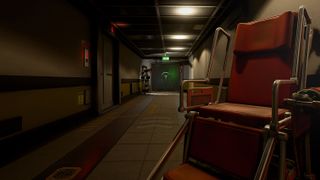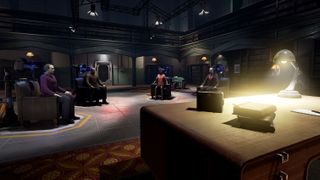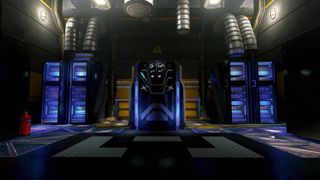Hands On With 'The Assembly' In VR, Solving Puzzles And Testing Morals

nDreams' The Assembly is a first-person VR game that places you in the role of two different characters. It’s hard to pinpoint what genre of game The Assembly should be considered because the game has elements of mystery, puzzle, and psychological thriller baked in. One thing’s for certain: you’ll be faced with difficult moral quandaries and choices.
You’ll also question everything
The Assembly starts off as more of a narrative than a game. For the first several minutes you find yourself inside various memory fragments that set the story's tone. Without giving too much away, you come to find that your character is a doctor named Madeline Stone, and she is facing repercussions for misconduct. Once the memories play out and you think you have an idea of where this story is heading your perspective changes.
The following scene puts you in the place of Dr. Cal Pearson. You soon find out that Pearson is a virologist with a conscience working for The Assembly, a scientific research facility full of brilliant minds with questionable morals.
After the initial setup scenes, the game gets more interactive. Throughout the game, you’ll switch between the perspective of Dr. Madeline Stone and Dr. Cal Pearson. Stone is being recruited to work for The Assembly, and Pearson is trying desperately to get out.

While playing as Madeline Stone, you’ll be asked to solve puzzles, and you’ll face dilemmas. At one point in the game, the decision I was forced to make actually brought tears to my eyes, which was very surprising; that's how immersed I was in the story.
While playing as Cal Pearson, your actions are less about choices as they are about being clever and meticulous. You have to find clues that will help you gain access to various areas of the building, such as pass codes or finding out where extra security cards are kept. The problems can sometimes be challenging to solve. It took me forever to find the sugar and sulfuric acid needed for a certain task, for example.
Control method
The Assembly is a first-person VR game, which made me worry that I wouldn’t be able to play it for long, comfort-wise. Generally, first-person games don’t work well for seated VR experiences in my experience, causing dizziness or nausea. Moving in VR without moving in the physical world can trigger VR sickness because of the disparity between what your eyes are seeing and what your vestibular system (balance and spatial orientation) perceives. Fortunately, there are ways to implement locomotion in VR comfortably and nDreams takes advantage of several of them.
Stay on the Cutting Edge
Join the experts who read Tom's Hardware for the inside track on enthusiast PC tech news — and have for over 25 years. We'll send breaking news and in-depth reviews of CPUs, GPUs, AI, maker hardware and more straight to your inbox.

Perhaps a short aside on this is in order. VR games are still working within a very new medium, but there are solutions for comfortably moving around in virtual worlds. Cloudhead Games is an invaluable source of wisdom in VR locomotion. The company pioneered comfort mode, which is a fancy name for snapping your view in to change directions at a preset degree of rotation. Instant movements tend to be much more acceptable than linear spinning camera views. Cloudhead Games also pioneered Blink, which allows you to move quickly through virtual environments. You point a cursor to where you want to move and hit a button to teleport to that location. The blink name refers to how the screen dims to black, similar to how intentionally blinking feels, and comes back to reveal the new area.

The Assembly actually takes advantage of both of these movement styles. You get to use Blink to travel greater distances, and you can use comfort mode snapping to change your direction by 90-degrees or more. nDreams also added another locomotion feature that I’ve never encountered before. The game will let you move around freely with the gamepad, but instead of a linear forward motion, your avatar will move in short instant movements. The result is very slow movements that are more precise and far more comfortable than steady motion.
Comfort
The combination of these three locomotion techniques makes for one of the most comfortable seated VR experiences I’ve ever had. Having multiple different movement options certainly adds to the complexity of the controls. I was using the Xbox One controller that comes with the Rift and it didn’t take long to get the hang of pulling the left trigger to initialize Blink. Pressing the A button to move took a few tries to get used to. Most VR teleport systems activate when you release the button that activates it.

Changing directions did get a little bit disorienting at times. Snapping the camera 90-degrees at a time can get confusing when you’re turning around in a corridor. It’s easy to forget which direction you came from. I found myself wondering back and forth through the map several times. Disorienting doesn’t mean dizzying. I did not experience any form of motion sickness while playing The Assembly.
So, What’s Not So Great About The Assembly?
nDreams describes The Assembly as a long-form game for VR, but I would actually say that the length of the game is its biggest weakness. I was able to finish The Assembly in two sittings that spanned approximately five hours. Those five hours were enjoyable, but I wanted more. The story builds into something interesting, but then it kind of just comes to an end.
I don’t want to ruin it for anyone. The game is absolutely worth your time. It will test your memory, your intelligence, and your moral compass. Just don’t expect it to last forever. It is true that this game is far from a tech demo, so in that regard nDreams has succeeded in making a long-form game, but there are elements of the story that the company could expand on significantly. Perhaps we’ll see a sequel one day.
The Assembly is available for the Oculus Rift from the Oculus Home store and for the HTC Vive or Oculus Rift through SteamVR. The Assembly can also be enjoyed on traditional 2D screens if you haven’t taken the jump into VR yet.
Kevin Carbotte is a contributing writer for Tom's Hardware who primarily covers VR and AR hardware. He has been writing for us for more than four years.
Most Popular



